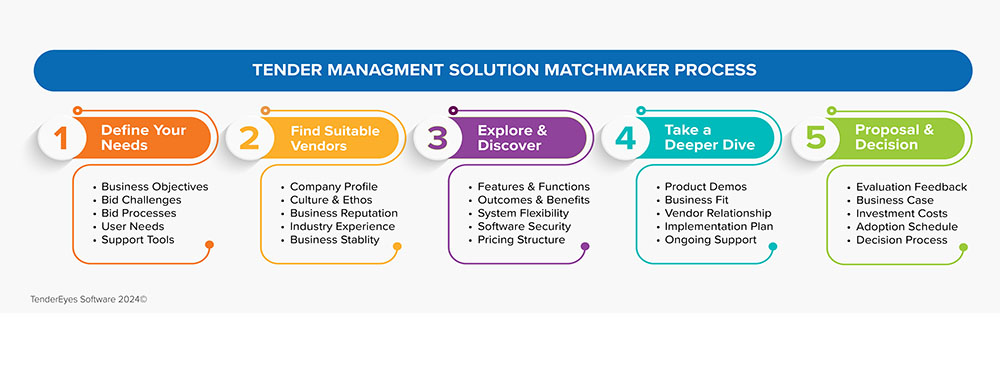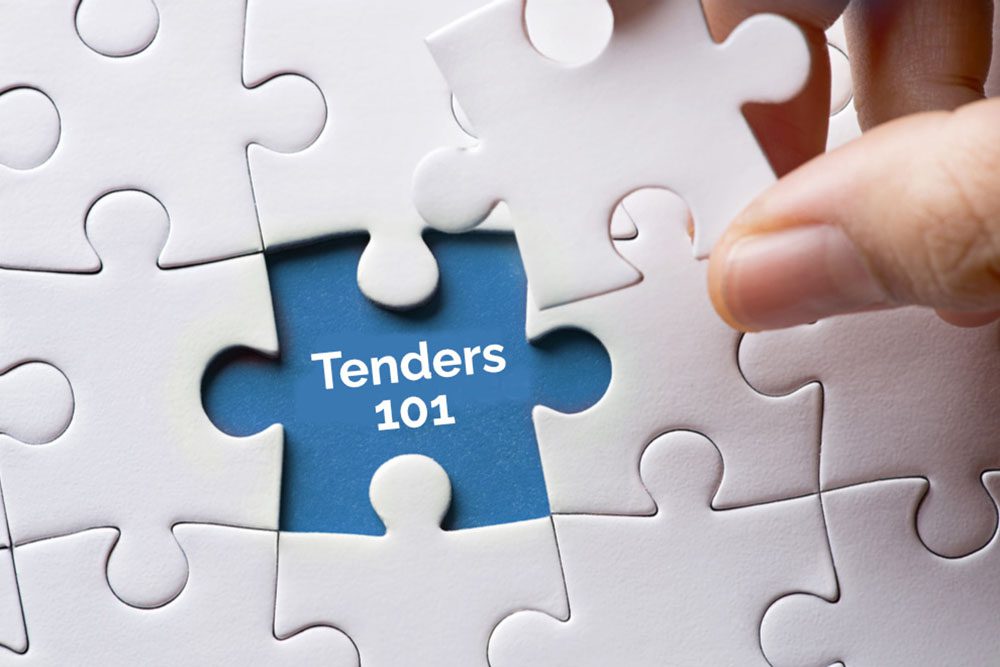Choosing the right technology and tender management software vendor is critical to your bidding success.
A dedicated tender management solution can significantly improve efficiency, compliance, and visibility across the whole tendering process. However, its important to not just focus on features and functions of any potential software! The people you will work with are equally important to the success of your digital transformation.
In this blog we will guide you through 5 steps to successfully evaluate and select a tender management software vendor. This will help find the best match for your technology investment.
The Tender Management Matchmaker Process
Choosing enterprise level software requires a thorough evaluation to confirm the solution is fit for your organisation’s purpose and required outcomes.
“84% of digital transformation projects fail to deliver their expected benefits.” Forbes
Following a logical process will help ensure comprehensive consideration of all key factors that will impact your implementation success! The TenderEyes Matchmaker Process provides an ideal template for undertaking this work.

Let’s now take a look at each step in detail.
Step 1. Define Your Needs
Before diving into the vendor selection process, it’s essential to have a clear understanding of your organisation’s specific needs and requirements. This will entail undertaking a comprehensive review of your current set up. This may feel daunting given the complexity of people, processes and tasks involved across the whole bid journey.
Having a dedicated project team to undertake this work will help share the load. Representatives of all teams that contribute to your bid activities need to be involved to ensure all experiences and viewpoints are considered. Your review should encompass the follows elements.
Business Objectives
It’s important to establish what you are looking to achieve from your process improvement and software investment. This may include improved efficiencies, better project tracking, enhanced communication and collaboration, more time to improve tender submissions or other priorities specific to your organisation.
Bid Challenges
Consider the current pain points and roadblocks in your tender management process. Are there issues with tender qualification, content management, compiling responses, collaboration or compliance that consistently impact your tender activities and results.
Bid Processes
Identity and map out your current processes and teams involved for your whole bid journey. Consider areas where you wish to streamline and improve workflows, activities, communication and collaboration.
User Needs
Establish who will be using the software. Ensure you gather input from all relevant stakeholders, including Sales and Bid Teams, Subject Matter Experts, Approvers and IT.
Support Tools
Undertake a review of the existing technology and tools used by stakeholders throughout the whole bid journey. Consider the ease of use, extent of integration and difficulties experienced by users.

Step 2. Find Suitable Vendors
Once you have a clear understanding of your needs, it is time to identify potential vendors. This will often involve an initial search on the internet.
Due to a cross-over of terminology there may be some confusion as to the solutions and vendors available. You will need to determine if you are seeking a fully dedicated tender management solution, such as TenderEyes, or a more simplistic RFP solution to manage proposals.
There are distinct difference between the two solutions:
- RFP Solutions: manage certain activities for the completion of proposals, with focus on content and whizzy document production.
- Tender Management Solutions: manage processes for the whole bid journey. Providing seamless interaction and tools for sourcing opportunities to managing content, compiling tender submissions and delivering won contracts.
Whichever solutions you choose to explore, you will need to consider several factors in getting to know your vendors. Vendor websites should provide key information and give you a sense of how they operate.
Company Profile
Company structure, teams, locations, products and services overview and customer base.
Culture & Ethos
Alignment of their values and philosophy to your own company culture and ways of working.
Business Reputation
Their position in the marketplace as a leader, innovator and thought-leader in tender management software.
Industry Experience
Demonstration of a proven track-record to build your confidence that they can successfully support your needs. This can be a It will be a significant advantage if the vendor is familiar with industry-specific requirements and challenges. Look for customer references and testimonials to gauge the vendor’s performance and customer satisfaction.
Business Stability
The financial stability and longevity of the vendor to ensure they will be around to support your organisation in the long term.
Step 3. Explore & Discover
Once you have identified several potential vendors, the next step is to explore the product further, including its features and functionality. A great deal of information can be gleamed through vendor websites, marketing communications and collateral.
Having undertaken your research, you will be in a good position to have initial discovery calls with your identified vendors.
Discussing your identified challenges and improvement objectives with vendors will help them better understand you needs. This will ensure they can properly ascertain the extent to which they can help support you.
This initial engagement will help you eliminate mis-matched vendors, saving you valuable time in the next stage of software evaluation.
When seeking a dedicated tender management solution, such as TenderEyes, considerations should be given to the following.
Features & Functions
Look for software features that can successfully deliver the following elements of your bid journey and processes including:
- Opportunity Management: a robust way to source and consistently qualify and approve your best-fit tender opportunities.
- Content Management: a central resource (Bid Library) with easy storage, creation, review, updating, approval and use of tender content and documentation.
- Project Management: easy project mobilisation with features to help streamline, automate and coordinate complex activities and tasks.
- Teamworking: collaboration tools that enable seamless communication and collaboration among team members and stakeholders.
- Supplier Management: facilitate effective partner and third-party supplier engagement and collaboration.
- Performance and Results Review: easy visibility and analysis of critical activity, performance and results data.
- Compliance and Auditing: comprehensive compliance tracking and audit trails to meet regulatory and internal requirements.
Outcomes & Benefits
Look for vendors that demonstrate they speak your language and can authoritatively talk about overcoming bid management challenges and the subsequent benefits achieved through their software.
System Flexibility
You should be able to confirm at this stage whether the solution has the ability to adapt to customer tender management needs now and in the future. This includes:
- Scalability: Can the software handle an increasing volume of users, tenders and suppliers as your organisation grows?
- Configuration & Customization: Can the software be configured and customized to fit specific workflows and processes?
- Integration: Can the software integrate with other business platforms such as ERP, CRM, and other tools?
Software Security
Given the sensitive nature of tender documents and procurement data, security is a paramount concern. Ensure the software vendor adheres to the highest security standards.
Pricing Structure
Some understanding at this stage as to vendors’ pricing structures will help you determine that the solution is a good match for your potential budget. This will include the cost of subscription charges for users, software configuration, customisation, training and ongoing support. It will be important to have discussions with your vendors to establish implementation schedules which may be a phased approached on activities and users, giving you more options on budgetary control.
Step 4: Take a Deeper Dive
After eliminating mis-matched vendors during the Explore & Discover Stage, it is time to take a deeper dive with the remaining suppliers.
You might be expecting to be able to do this through a free trial, as is common with standard off-the-shelf business software. However, due to the complexity of the bid process and the potential need for configuration and customization, trials are not generally offered by tender management software vendors.
Product Demonstration
So, on to the product demonstration. Hopefully during your discovery call, you have agreed your top 2-3 priority challenges and areas for improvement. This will allow the vendor to tailor the demonstration accordingly.
It will be important to establish who within your organisation, needs to be involved in the product demonstration. In fact, several demonstrations may need to be arranged depending on the complexity of your company procurement structure, IT management and teams involved in your bid activities.
It’s certainly important to have representatives of all teams involved including, Sales, Bid Teams, Subject Matter Experts and Approvers. This will help ensure consideration is given to all aspects of the bid journey in the product assessment.
The product demonstration will allow you to see features and functions in action and ascertain usability expectations. A clean, intuitive user interface can significantly enhance user experience, reduce the learning curve and increase long-term adoption and use.
Business Fit
The product demonstration and further discussions between your teams and the vendors will help you establish which solution/s offer a good fit for your business needs.
You want to be reassured that the solution will align with your organisation’s existing or proposed improved processes and workflows. Plus be able to seamlessly integrate with other business support platforms such as CRM and ERP to ensure minimal disruption during implementation.
It’s crucial that the software has the flexibility to be configured and customised to meet your specific needs, such as accommodating unique tender requirements, approval workflows, or reporting standards.
Additionally, it should offer scalability to grow with your business, whether that means handling more complex tenders, supporting additional users, or integrating with other enterprise systems as your company expands.
Vendor Relationship
Choosing a tender management solution is not just about the software, but also the long-term relationship you will have with the vendor team.
Consider if you have built a level of rapport and trust with your vendor team. You want to feel confident that you can work well together, and they will effectively support you in delivering a successful implementation. Not just at the time of adoption but in the long-term.
Vendor’s that can demonstrate a deep level of experience and expertise in tender management challenges, activities and best practices, will prove invaluable in ensuring the solution gives you the most value.
Implementation Plan
It will also be important at this stage to understand the implementation process and timescales. This will also give you insight into the level of support potential vendors will be providing during this critical stage of adoption.
Key considerations include:
- Configuration & Customisation: Establish with the vendor what is covered by standard configuration and determine how much bespoke customisation you need. This will impact your implementation timescales but may be achieved over a phased period.
- User Training: Early engagement and buy-in from your users will be paramount to adoption. Ensure the vendor can provide a comprehensive training package to set your team up for success.
- Testing and Go Live: Ensure you have time scheduled to test the solution thoroughly before your Go Live. This will help ensure adoption frustrations are kept to the minimum.
- Implementation Plan: At this stage you will also want some indication of the vendor’s implementation process and indicative timescales. Your actual implementation will depend on the extent of the work required in training, configuration and customisation which can be finalised in the next step.
It will be important to establish who from the vendor team will be supporting you through the process. Is it the same team you have been dealing with and built rapport or a new team that you haven’t yet met? If it is a different team you need to ensure you will have a good connection with them and there is continuity between the sales process and implementation.
Ongoing Support
The level of support provided by the vendor can significantly impact the long-term success of your tender management software investment.
You are looking for a vendor that will provide comprehensive support services, including technical support, user training, on-line learning and regular updates.
A vendor that promotes best practice and will actively engage and support you in on-going bid management improvements will be invaluable. Your solution should provide a strong foundation for delivering core activities, smarter working and enhanced expertise.
Step 5: Proposal & Decision
The final step in evaluating bid management software vendors involves gathering proposals and making a well-informed decision based on comprehensive feedback and analysis. At this stage you may already have chosen your preferred supplier or have a couple of options to consider.
Evaluation Feedback
It is essential to collect and analyse feedback from all stakeholders involved in the evaluation process. This should cover considerations as discussed above, such as user experience, functionality, ease of integration, and support services. This will help you identify any gaps between the vendor’s offerings and your organisation’s specific requirements, ensuring that the chosen software meets expectations.
Business Case
Crafting a solid business case is crucial for securing buy-in and funding from decision makers. Your vendor should provide a comprehensive proposal, contract terms and service level agreement for consideration. This needs to be backed up with your recommendations, highlighting how the selected software will address current inefficiencies in your tender management process, drive value, and align with long-term business goals.
Detailing how the software will reduce costs, improve efficiency, and enhance tender success rates will provide a strong indication of Return on Investment. A well-articulated business case can be the deciding factor in your organisation moving forward with the investment.
Any support your vendor can provide to support and substantiate your business case will be advantageous. This may include proven industry relevant case studies, performance statistics and customer references you can liaise with for first-hand experience and feedback.
Investment Costs
Cost will be a major factor in your decision making. It is therefore important to consider the total cost of ownership. This not only includes licensing fees but implementation costs, training, and ongoing support. This needs to include both vendor costs and internal staffing costs.
It’s important to compare these costs against the projected benefits outlined in your business case. Ensure that the investment aligns with your budgetary constraints and offers a clear financial return over time. Additionally, discuss any potential hidden costs or future price increases with the vendor to avoid unexpected expenses.
Adoption Schedule
By now you will have established the scope of the project, including configuration and customisation needs and user numbers. You will need to assess the vendor’s proposed adoption schedule, including milestones for installation, customisation, training, testing and full deployment.
The vendor should offer a realistic timeline that minimizes disruption to your ongoing projects and ensures a smooth transition for users. A well-planned adoption schedule will help reduce risks associated with change management and ensure that the software delivers value as quickly as possible.
Decision Process
Finally, establish a clear decision-making process that involves all key stakeholders.
This process should include reviewing the gathered feedback, evaluating the business case, assessing the total investment, and confirming the feasibility of the adoption schedule.
It’s also wise to consider the vendor’s long-term stability, reputation, and customer support capabilities. By ensuring that all critical factors have been thoroughly evaluated, you can make a confident and informed decision on the best bid management software for your organisation.









